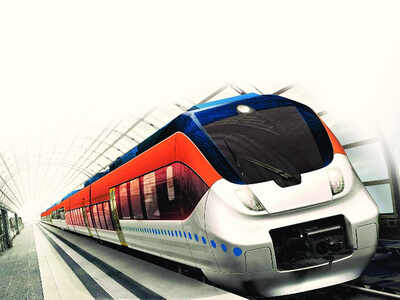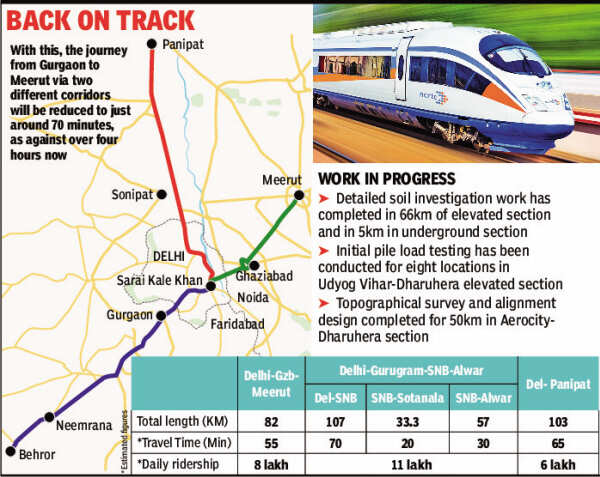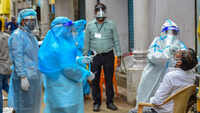
GURUGRAM: After losing three crucial months due to the lockdown, work on the Delhi-Gurugram-SNB Regional Rapid Transit System (RRTS) corridor is finally catching pace. The pre-construction phase of the project has already begun at multiple locations in the city to finalise the detailed structural design so that no time is lost in beginning the construction of the RRTS post the project sanction, said the National Capital Region Transport Corporation (NCRTC).
NCRTC, the nodal agency implementing RRTS, has started a detailed designing of three RRTS stations of the Delhi-Gurugram-SNB RRTS corridor. Work on multiple preliminary stages of the RRTS such as project office setup, road widening, geo-technical investigation, shifting of utilities among others have already begun in areas such as Udyog Vihar, Atul Kataria Chowk, IFFCO Chowk, Dharuhera, among others.

To save time, NCRTC is focusing on completing most of the pre-construction activities for the corridor so that the civil construction of the corridor can start immediately. It has appointed L&T Infra as the Detailed Design Consultant (DDC) for civil, architectural, and other design-related works for an elevated viaduct between IDPL complex Ramp to Rajiv Chowk Ramp and the three elevated stations in the city — Udyog Vihar, Sector 17, Rajiv Chowk.
Sudhir Kumar Sharma, chief PRO of NCRTC, said, “We did lose around three months due to the lockdown. In May, once lockdown was eased, we began the work but now the project is catching momentum. Just like the Delhi-Ghaziabad-Meerut corridor, we are expediting pre-construction work on Delhi-Gurugram-SNB segment. Once this phase is completed, there’ll be a proof-check of the design. We are also working out supervision and quality-check mechanisms."
With simultaneous development of the Dwarka expressway, the RRTS will not only ease traffic woes in the city but will also bring down accidents, experts feel.
Prakhar Sahay, former joint secretary of the Dwarka expressway welfare association, said, “RRTS is a very important for the city. At two important intersections of the Dwarka expressway, RRTS is connected. One is at the beginning of Package 1 and other at the end of Package 4 at cloverleaf. While the Centre is working hard to provide good connectivity, the same enthusiasm lacks in state governments when it comes to Metro.”
The 107-km long Delhi-Gurugram-SNB corridor will be elevated for about 72km (11 stations), the remaining 35km (five stations) will be underground.
NCRTC, the nodal agency implementing RRTS, has started a detailed designing of three RRTS stations of the Delhi-Gurugram-SNB RRTS corridor. Work on multiple preliminary stages of the RRTS such as project office setup, road widening, geo-technical investigation, shifting of utilities among others have already begun in areas such as Udyog Vihar, Atul Kataria Chowk, IFFCO Chowk, Dharuhera, among others.

To save time, NCRTC is focusing on completing most of the pre-construction activities for the corridor so that the civil construction of the corridor can start immediately. It has appointed L&T Infra as the Detailed Design Consultant (DDC) for civil, architectural, and other design-related works for an elevated viaduct between IDPL complex Ramp to Rajiv Chowk Ramp and the three elevated stations in the city — Udyog Vihar, Sector 17, Rajiv Chowk.
Sudhir Kumar Sharma, chief PRO of NCRTC, said, “We did lose around three months due to the lockdown. In May, once lockdown was eased, we began the work but now the project is catching momentum. Just like the Delhi-Ghaziabad-Meerut corridor, we are expediting pre-construction work on Delhi-Gurugram-SNB segment. Once this phase is completed, there’ll be a proof-check of the design. We are also working out supervision and quality-check mechanisms."
With simultaneous development of the Dwarka expressway, the RRTS will not only ease traffic woes in the city but will also bring down accidents, experts feel.
Prakhar Sahay, former joint secretary of the Dwarka expressway welfare association, said, “RRTS is a very important for the city. At two important intersections of the Dwarka expressway, RRTS is connected. One is at the beginning of Package 1 and other at the end of Package 4 at cloverleaf. While the Centre is working hard to provide good connectivity, the same enthusiasm lacks in state governments when it comes to Metro.”
The 107-km long Delhi-Gurugram-SNB corridor will be elevated for about 72km (11 stations), the remaining 35km (five stations) will be underground.
Quick Links
Kerala Coronavirus Helpline NumberHaryana Coronavirus Helpline NumberUP Coronavirus Helpline NumberBareilly NewsBhopal NewsCoronavirus in DelhiCoronavirus in HyderabadCoronavirus in IndiaCoronavirus symptomsCoronavirusRajasthan Coronavirus Helpline NumberAditya ThackerayShiv SenaFire in MumbaiAP Coronavirus Helpline NumberArvind KejriwalJammu Kashmir Coronavirus Helpline NumberSrinagar encounter
Get the app








